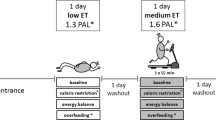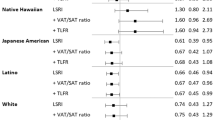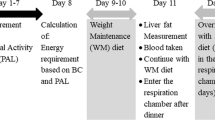Abstract
We report associations of saturated fat (SF) intake with impaired fasting glucose (IFG), impaired glucose tolerance (IGT), concurrent IFG+IGT and type 2 diabetes (T2DM) at different levels of cardiorespiratory fitness and body mass index (BMI). In a population-based sample (n=1261, age 58–78 years), oral glucose tolerance, 4-day food intake and maximal oxygen uptake were measured. High intake of SF (>11.4 E%) was associated with elevated risk for IFG (4.36; 1.93–9.88), concurrent IFG+IGT (6.03; 1.25–29.20) and T2DM (4.77; 1.93–11.82) in the category of high BMI (>26.5) and high fitness, whereas there was no significantly elevated risk in individuals reporting low intake of SF. Concurrent high BMI and low fitness were associated with elevated risks. In general, SF intake and fitness did not differentiate the risk of abnormal glucose metabolism among subjects with low BMI. Limited intake of SF may protect from diabetogenic effects of adiposity, but only in individuals with high level of fitness.
This is a preview of subscription content, access via your institution
Access options
Subscribe to this journal
Receive 12 print issues and online access
$259.00 per year
only $21.58 per issue
Buy this article
- Purchase on Springer Link
- Instant access to full article PDF
Prices may be subject to local taxes which are calculated during checkout
Similar content being viewed by others
References
van Dam RM, Willett WC, Rimm EB, Stampfer MJ, Hu FB . Dietary fat and meat intake in relation to risk of type 2 diabetes in men. Diabetes Care 2002; 25: 417–424.
Heikkila HM, Schwab U, Krachler B, Mannikko R, Rauramaa R . Dietary associations with prediabetic states-the DR's EXTRA Study (ISRCTN45977199). Eur J Clin Nutr 2012; 66: 819–824.
Savonen K, Krachler B, Hassinen M, Komulainen P, Kiviniemi V, Lakka TA et al. The current standard measure of cardiorespiratory fitness introduces confounding by body mass: the DR's EXTRA study. Int J Obes 2012; 36: 1135–1140.
Weyer C, Bogardus C, Pratley RE . Metabolic characteristics of individuals with impaired fasting glucose and/or impaired glucose tolerance. Diabetes 1999; 48: 2197–2203.
Coker RH, Williams RH, Yeo SE, Kortebein PM, Bodenner DL, Kern PA et al. The impact of exercise training compared to caloric restriction on hepatic and peripheral insulin resistance in obesity. J Clin Endocrinol Metab 2009; 94: 4258–4266.
Clore JN, Stillman JS, Li J, O’Keefe SJ, Levy JR . Differential effect of saturated and polyunsaturated fatty acids on hepatic glucose metabolism in humans. Am J Physiol Endocrinol Metab 2004; 287: E358–E365.
Westerbacka J, Lammi K, Hakkinen AM, Rissanen A, Salminen I, Aro A et al. Dietary fat content modifies liver fat in overweight nondiabetic subjects. J Clin Endocrinol Metab 2005; 90: 2804–2809.
Johnson NA, Sachinwalla T, Walton DW, Smith K, Armstrong A, Thompson MW et al. Aerobic exercise training reduces hepatic and visceral lipids in obese individuals without weight loss. Hepatology 2009; 50: 1105–1112.
Bae JC, Rhee EJ, Lee WY, Park SE, Park CY, Oh KW et al. Combined effect of nonalcoholic fatty liver disease and impaired fasting glucose on the development of type 2 diabetes: a 4-year retrospective longitudinal study. Diabetes Care 2011; 34: 727–729.
Rosell MS, Hellenius ML, de Faire UH, Johansson GK . Associations between diet and the metabolic syndrome vary with the validity of dietary intake data. Am J Clin Nutr 2003; 78: 84–90.
Acknowledgements
The DR’s EXTRA Study was supported by grants from Ministry of Education and Culture of Finland (627; 2004–2011), Academy of Finland (104943; 123885), European Commission FP6 Integrated Project (LSHM-CT-2004-005272; EXGENESIS), Kuopio University Hospital, Finnish Diabetes Association, Finnish Foundation for Cardiovascular Research, Päivikki and Sakari Sohlberg Foundation, City of Kuopio and Social Insurance Institution of Finland. HMH was supported by a grant from the Juho Vainio Foundation. We also want to acknowledge the substantial contributions of reviewers in shaping the final version of the manuscript.
Author information
Authors and Affiliations
Corresponding author
Ethics declarations
Competing interests
The authors declare no conflict of interest.
Additional information
Guarantor: R Rauramaa.Contributors: MH, RR contributed to the study conception and design. HMH, KS, MH contributed to data collection. HMH, BK, KS, MH analyzed the data. HMH, BK, MH, RR, USS contributed to data interpretation and discussion. HMH wrote the manuscript. HMH, BK, KS, MH, RR, USS reviewed/edited the manuscript. RR is a guarantor of the study.
Rights and permissions
About this article
Cite this article
Heikkilä, H., Krachler, B., Savonen, K. et al. Combined low-saturated fat intake and high fitness may counterbalance diabetogenic effects of obesity: the DR’s EXTRA Study. Eur J Clin Nutr 67, 1000–1002 (2013). https://doi.org/10.1038/ejcn.2013.138
Received:
Revised:
Accepted:
Published:
Issue Date:
DOI: https://doi.org/10.1038/ejcn.2013.138



